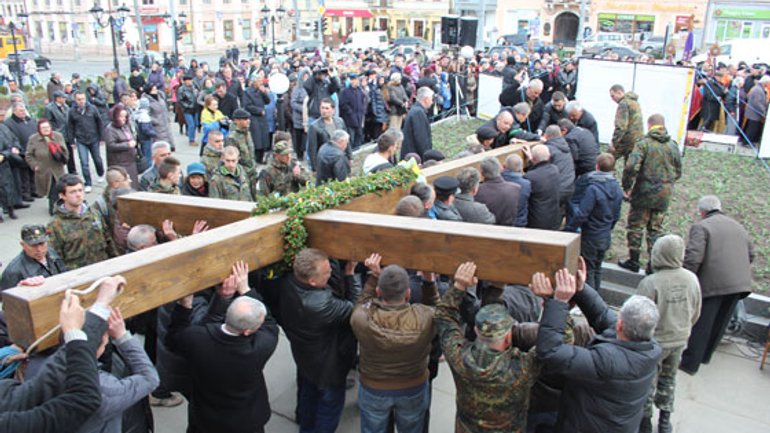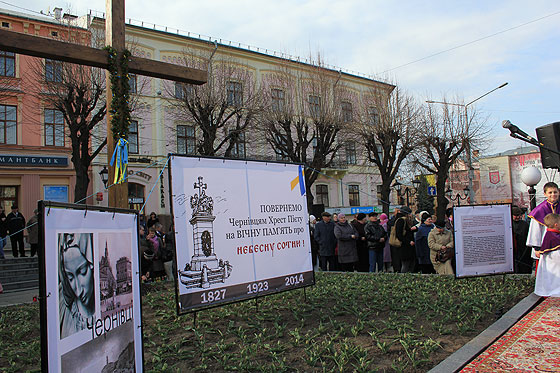Chernivtsi Restores the Pieta

Restoration of the shrine
Not long ago the Greek and Roman Catholics of the city blessed this place and a huge oak cross was installed. It is temporary and it will remain there until the Pieta rises.
The Greek Catholic community of Chernivtsi sought to restore the Pieta already at the beginning of the 1990s. For almost 20 years the people wereignored by the authorities. So the appearance of the cross in the city’s central square is a great joy for the Christians of the city.
Now in the square beside the cross there are posters telling the Pieta’s history. Meanwhile, by the decision of Secretary of the Chernivtsi City Council Yaroslav Kushniruk a special commission has been set up, consisting of architects, sculptors, and lawyers. The commissioner of the monument installation is the charitable foundation Caritas Bukovyna. At the meeting of clergy of the UGCC vicarage of Bukovyna and the local Union of Artists it was agreed that the artists and sculptors would help prepare everything necessary for the contest for the best design of the Pieta. The respective contest will be announced in the near future.
Fr.Valeriy Syrotyuk, Bukovyna Vicar of UGCC, said: “The main requirement is to make a design of the Pieta on the model of the old monument – the one that we cannot restore, for no exact drawings have survived. So we must create a new Pieta. We’d like to hold this open contest before the dedication day of our Cathedral – the Assumption of the Mother of God. The three best sculptors’ works will be presented for public discussion.”
When the place for the Pieta was blessed, it was decided to put a cross there for the time being. “It will sanctify this square. Besides, we won’t be reproached that the Pieta is installed in the place where Lenin had formerly stood until1991,” said Fr.Valeriy.
The history that cannot be returned
The statue of the Mother of God with the Son in Her arms appeared in Chernivtsi in 1827. It was installed by the Greek Catholic Lazar Mykhaylovych at his own cost.

“It was one of the most well-known monuments of Chernivtsi,” says Fr.Valeriy. “It stood in the center of the city in the former Market (Rynok) square. At that time in Chernivtsi there were 900 houses and its population was 9,000 people.This monument was a symbol of compassion, love and tolerance, and protection for all the ethnicities who lived here. Our city has survived different empires. But it was the Austrian Empire that left a grateful mark in the region’s history. And when the Romanians came, they installed a monument to a Romanian warrior with a bull beside him, who stompedon the former empire, which was represented by an eagle. It was a sort of violent scene. The Romanian authorities, however, did not destroy the Pieta, but transferred it to a Jesuit church.”
In Soviet times the Pieta was smashed with sledgehammers. The monument of Lenin then stood in the central square until 1991. And starting from 1991 the UGCC community regularly reminded the authorities that the Pieta should be restored. Sometimes there was some progress, as, for example, in 1999, when the Cabinet of Ministers passed a decision and the Pieta of Chernivtsi was added to the list of monuments to be restored. “I remember the times when there was a discussion, and I don’t know whether it was a delay of the process or just unwillingness. I think it was unwillingness. Had it been the initiative of another church (you know what church I am talking about), the authorities would have upheld it. And the answer we received was like this: we cannot restore it, we do not have enough drawings of how it used to look,” said Fr.Valeriy Syrotyuk.
It should be noted that in the same 1991, when Chernivtsi said farewell to the communist leader, famous historian Oleksandr Masan published an article in one of the local newspapers “Let’s Return the Mother of God,” where he stated that the Pieta had to rise again in the heart of Chernivtsi, and made a brief excursion into the monument’s past.
“Without exaggeration,” states the candidate of historical science, associate professor at Chernivtsi National University, “the Pieta was a shrine for the majority of citizens of Chernivtsi. And the following example attests to it. In 1875 it was proposed to transfer the Pieta to another place, and to install in the center of the city a monument dedicated to the 100th anniversary of the accession to Austria-Hungary.Butcity’s residentsdid not allow this.As for the Greek Catholic community, it should be noted that intheold days it was right beside the Pieta where they blessed the water on the feast of Epiphany. At a meeting of the special committee, it was decided to restore the Pieta as close to the original as possible. After all, no drawings or samples survived. It is known that after the Pieta was destroyed, the fragments were buried in a pit, which was later filled with a thick layer of clay, so even archaeologistscannot help us.”
The renewal of the Pieta in Chernivtsi will be dedicated to the memory of the heroes of the Heavenly Hundred. This monument will rise in the center of the city in memory of those Ukrainians, for whom Ukraine will cry for a long time to come.
Pieta for the Heavenly Hundred
“After we experienced the Maidan, the need arose for a place to honor the Heroes of the Maidan,”Fr.Valeriy reflects. “And then someone came up with idea that we do not need to invent something new in Chernivtsi, as the image of Pieta – the Lamentation of Christ by the Mother of God – conveys both suffering and faith, love and compassion. Mary’s eyes are not the eyes of a mother, who is looking for the murderer, or who falls into hatred. She has both a sorrowful and pious expression.A face of a mother, who, when looking at Her Son, does not see Him dead, but sees his resurrection. It is also the face of the present Ukraine, whichnever talks about revenge. Our Ukrainian tolerance knows no such word. And in the face of Jesus we see those heroes, who were unjustly convicted, innocently crucified and killed. But their memory lives forever and they are a symbol of Ukraine, which has risen again,” says the priest.
During the blessing of the cross 13,000 hryvnias were collected for the construction of the Pieta. “But if every citizen of Chernivtsi donates at least one hryvnia (more than 250,000 people live in the city) it will be enough to return the Mother of God to Chernivtsi,” say the proponents of restoring the Pieta.









